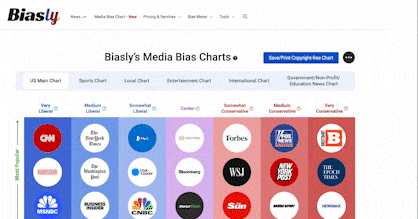 Deseret News Article Rating
Deseret News Article RatingOpinion: The evolution of religious freedom
- Bias Rating
- Reliability
N/AN/A
- Policy Leaning
48% Medium Right
- Politician Portrayal
16% Positive
Continue For Free
Create your free account to see the in-depth bias analytics and more.
By creating an account, you agree to our Terms and Privacy Policy, and subscribe to email updates.
Bias Score Analysis
The A.I. bias rating includes policy and politician portrayal leanings based on the author’s tone found in the article using machine learning. Bias scores are on a scale of -100% to 100% with higher negative scores being more liberal and higher positive scores being more conservative, and 0% being neutral.
Sentiments
N/A
- Liberal
- Conservative
| Sentence | Sentiment | Bias |
|---|---|---|
Unlock this feature by upgrading to the Pro plan. | ||
Reliability Score Analysis
Policy Leaning Analysis
Politician Portrayal Analysis
Bias Meter
Extremely
Liberal
Very
Liberal
Moderately
Liberal
Somewhat Liberal
Center
Somewhat Conservative
Moderately
Conservative
Very
Conservative
Extremely
Conservative
-100%
Liberal
100%
Conservative

Contributing sentiments towards policy:
60% : Courts do play an important role in defending religious liberty, and we should seek to find and support the best standards that embody the Constitution's commitment to religious freedom.59% : The Supreme Court's understanding of religious freedom is changing under our feet.
57% : Yet, the justices can only do so much to protect religious liberty; the real work of building a society that protects this vital First Amendment right belongs to each of us.
56% : Decided in 2018 and 2021, respectively, these decisions were anticipated to be blockbuster cases in religious liberty law, either primed to embrace or refute the standard in Smith.
56% : Fulfilling these responsibilities gives substance to religious freedom, which naturally leads policymakers to want to preserve religious rights.
55% : Yoder took his case to court, claiming that his right to the free exercise of religion under the First Amendment had been denied.
48% : Smith can apparently be used to accommodate religious liberty or not, depending on how it is applied.
48% : The defending of religious freedom that affects most of us will be localized and practical rather than nationalized and abstract.
45% : As Dallin H. Oaks, first counselor in the First Presidency of The Church of Jesus Christ of Latter-day Saints and former Utah Supreme Court jurist, has stated, courts should be viewed as a "final fallback" rather than our "first recourse" for defending religious freedom.
44% : Similarly, the Fulton case again found a way to use Smith to protect religious liberty rather than attack it.
43% : Due to religious convictions, the Catholic Social Services of Philadelphia would not conduct home studies for same-sex couples hoping to foster, but would instead refer them to another agency in the city.
42% : The second -- known as the "Smith test" -- sets a much lower bar for religious liberty: It asks whether the government's action was "neutral" and "generally applicable" --
40% : A member of the Old Order Amish religion, Yoder believed that his children should not attend public school past the eighth grade.
*Our bias meter rating uses data science including sentiment analysis, machine learning and our proprietary algorithm for determining biases in news articles. Bias scores are on a scale of -100% to 100% with higher negative scores being more liberal and higher positive scores being more conservative, and 0% being neutral. The rating is an independent analysis and is not affiliated nor sponsored by the news source or any other organization.























